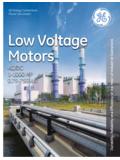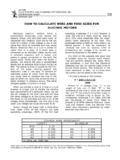Transcription of Overheating Electric Motors - Gesper Systems
1 Overheating Electric Motors : One Root Cause of Insulation Failure Modern Plant Management widely accepts predictive maintenance as a significant source of cost savings. However, preventive maintenance is still viewed as an alternative. This fact is based upon yesterday's technologies being unable to succeed at root cause analysis. With respect to the diagnostic electrical tool belt, the days of the handheld multi-meter and the meg-ohm meter as sole tools in cost effective maintenance is over. Modern on-line technologies permit easy assessment of the whole motor system, which is comprised of the power, motor and load.
2 By focusing on the whole motor application instead of one or two components, true troubleshooting solutions become available. Professional Standards Maintenance experts agree that excessive heat cause rapid deterioration of the winding insulation within Motors . The common rule states, for every 10oC of additional heat to the windings, the insulation life is cut in half. For example, a motor that would normally last 20 years in regular service is running 40oC. above rated temperature. Under these conditions, the motor would have a life of 1/16 or about one year the length as it would have if it were running at rated temperature.
3 Many articles and studies have been done that agree with this rule. Leading standardization organizations have come to the conclusion that 30% of motor failures are contributed to insulation failure and 60% of these are overwhelmingly caused by Overheating . Also other organizations have published article stating that a significant cause of bearing deterioration is Overheating . There are typically five main reasons for Overheating . These items include overload, poor power condition, high effective service factor, frequent stops and starts, and environmental reasons. Overload Conditions Stator current is a frequently used measurement of load level but it can easily be masked by an overvoltage condition.
4 A common mistake is made in the practice of operating at an over-voltage in order to reduce the stator current. The hope is to proportionally reduce the introduction of heat. It has been shown that for Motors ranging from 10 to 200hp, that the decrease of losses obtained by operating at a 10% overvoltage would typically be only 1 to 3%. Even though the current of a motor may vary strongly when applying over-voltages, the excessive damaging heat in the motor will not improve. A. more than 10% load error can be introduced due to relying on stator current readings to access probable load and expected heat levels.
5 Under full load conditions, this can mean life and death to a motor . In an example taken from a coal-fired power plant in the United States, a 7000 hp motor was running with only 7% over current, but with an 8% over voltage. Two identical applications had previously undergone unscheduled outages within the last 12 months. Looking at the stator current of this motor , a mild overload had been identified. Only after looking at the true load to the motor , was an overload of nearly 20% discovered. This explains why these Motors were failing. The repair for each of these Motors ran in the hundreds of thousands of dollars.
6 Under industrial applications, perfect voltage conditions are rare. One must remember that losses, and not current level alone, are the true source of heat. These losses are a destructive factor to windings and represent a significant reason for bearing damage. This justifies the need for accurate knowledge of operating load level. Only accurate load level calculations can give reliable measurements of excessive losses and Overheating in the motor . This permits effective use in preventive maintenance environments. Power Condition Due to typical poor power conditions within manufacturing plants, Electric Motors generally need to be derated in order to maximize useful life.
7 NEMA. MG-1 sections II and IV specify what voltage quality, as a function of balance and distortion, allows what level of percentage load. Figure 1 shows the NEMA derating curve for percentage of unbalance. This figure is also defined in the following formula: Fig 1: NEMA Derating Curve 100 Maximum Voltage Deviation from Average Voltage % Unbalance =. Average Voltage The use of the derating curve is best described as the higher the level of unbalance, the lower the acceptable level of steady state load. For example: If you had a 100 hp motor and an unbalance factor of 3%, you would need to derate the motor to or 90%.
8 Of capacity, meaning 90 hp. The frequent use of Variable Frequency Drives (VFD's) is showing detrimental effects to Electric Motors due to the condition of power within manufacturing facilities. Figure 2. shows the voltage that a VFD, running at almost a 6-pulse mode, will send to the motor . The distorted currents are the Motors reaction to the poor power condition. Very severe distortions are evident. This scenario shows a NEMA derating of This allows the motor to be operated at 70%. output. Fig 2: Extreme distortion with a slow switching VFD (50hp, 4-pole). Effective Service Factor Bringing voltage and current level, operating speed and input power standards to the field is no trivial matter.
9 Until recently there has been no accurate measurement based load estimation method. The key to finding the most frequent reasons of Overheating is proper load level identification. To perform this, it is crucial to have the best possible accuracy in the estimation of load level. This can be obtained by looking at only currents and voltages. In the past, less accurate methods lead to wide mis-assessments, in particular in cases where voltage conditions lack optimal level, balance and distortion. Unfortunately these conditions are common in the field. The formula for calculating effective service factor is: % Load Effective Service Factor =.
10 % NEMA Derating The key benefit effective service factor offers is the combination of professional standards and real life applications. This allows predictive maintenance professionals a solid conclusion of stress on any particular motor -load application. From data gathered on a dynamometer a 300hp motor under test was running a nearly full load, Voltage distortion was poor due to a previously unidentified SCR. defect in the power supply. The resulting NEMA derating factor of renders to an effective service factor of , which signaled an alarm condition. Regardless of nameplate service factor ( ), any motor operating above is under stress.






